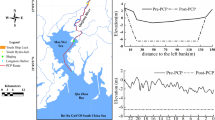Abstract
The Yangtze Estuary plays an important role in the economic development in the Yangtze River Basin, China. Shanghai is a megalopolis, and more than 70% of its water is supplied from the Yangtze Estuary. Salinity intrusion has become the most restrictive factor for water supply in nature, while the North Branch is the most serious branch compared to others where the salt water in water sources mainly comes from. If the North Branch is properly blocked, construction of tidal gate for example, may alleviate the salinity intrusion. In this chapter, a numerical model is established to study the fresh water distribution characteristic and the impact of the salinity intrusion on the water sources after the North Branch is fictitious blocked. The study shows that salinity intrusion in the Yangtze Estuary is the most serious in January, during which the safety of water sources is likely to be threatened by salt water. The salinity would be greatly reduced in the water sources intake with the North Branch blocked. The salinity of the water intake in the Dongfengxisha Reservoir and Chenhang Reservoir would be close to 0 in any condition while the Qingcaosha Reservoir is still threatened by salt water when continuous northerly wind happens. This study could provide a reference for the discovery of measures for the water source safety in the Yangtze Estuary.
Access this chapter
Tax calculation will be finalised at checkout
Purchases are for personal use only
Similar content being viewed by others
References
Chen, J., & Zhu, J. R. (2014). Source for saltwater intrusion at the water intake of Qingcaosha Reservoir in the Changjiang Estuary. Acta Oceanologica Sinica, 36, 131–141.
Dai, R., & Zhu, J. R. (2015). Statistical analysis of the wind at the Chongming Eastern Beach. Journal of East China Normal University(Natural Science), 4, 17–25.
Ding, L., Dou, X. P., Gao, X. Y., et al. (2015). A review on salt water intrusion in Yangtze Estuary, China. In 17th China marine (Offshore) engineering symposium, China.
Ding, L., Dou, X. P., Gao, X. Y., Hai-Dong, X. U., & Jiao, J. (2016). Analysis of saltwater intrusion into Yangtze Estuary during dry seasons of 2013 and 2014. Hydro-Science and Engineering, 4, 47–53.
Ding, L., Dou, X. P., Gao, X. Y., et al. (2017a). Response of salinity intrusion to winds in the Yangtze Estuary. In 5th international conference on hydraulic engineering hydraulic engineering V of P.R. China, Shanghai.
Ding, L., Gao, X. Y., Dou, X. P., et al. (2017b). Research of the influence of salinity intrusion on Qingcaosha water source. In 5th IAHR WORLD CONGRESS-managing water for sustainable development, learning from the past for the future, Malaysia.
Gu, Y. L., Wu, S. P., & Le, Q. (2003). Impact of intruded saline water via north branch of the Yangtze river on water source areas in the estuary area. Yangtze River, 34, 1–3.
Hu, C. X. (1989). Research on evaluation method of the Yangtze Estuary salinity intrusion. Water Resources Protection, 4, 34–37.
Huang, J. X., & Xu, J. Y. (1996). Research of the address of the second water source in Shanghai. Water Resources Planning and Design, 1, 15–20.
Jin, Y. H., & Sun, Z. L. (1992). Mixing characteristics of salt water and fresh water in Chinese Estuarie. Acta Geographica Sinica, 2, 165–173.
Kuang, C. P., Huang, J., Chen, S. Y., et al. (2012). A saltwater intrusion model based on semi-implicit Eulerian-Lagrangian finite-volume method. Journal of Tongji University (Natural Science), 40, 38–44.
Le, Q., et al. (2009). Study on location of water intake and water drawing method in QingCaoSha reservoir. Water & Wastewater Engineering, 35, 46–51.
Li, L. (2011). Spatial-temporal dynamic characteristics of saltwater intrusion in the Changjiang Estuary. ShangHai: East China Normal University.
Luo, X. F., & Chen, Z. C. (2005). Numerical simulation study of effect of runoff and tide on the Changjiang river mouth saltwater intrusion. Coastal Engineering, 3, 1–6.
Shen, H. S., & Huang, Y. L. (1987). Primary study of the three Gorges Dam influence’s on salinity intrusion in Yangtze Estuary. Yangtze River, 10, 30–33.
Sun, Z. H., Yan, X., Xie, C. S., & Li, Q. (2017). An empirical predictive model for saltwater intrusion in the south branch influenced by tidal flow from the north branch in the Yangtze River Estuary. Advances in Water Science, 28, 213–222.
Tang, J. H., Xu, J. Y., Zhao, K. W., & Liu, W. W. (2011). Research on saltwater intrusion of the south branch of the Changjiang Estuary based on the measure data. Resources and Environment in the Yangtze Basin, 06, 677–684.
Tao, X. W. (1991). Primary study of the address for the water intake at second water source (the Yangtze Estuary) in Shanghai. Ocean Development and Management, 3, 69–74.
Wang, S. X., & Zhu, J. R. (2015). Saltwater intrusion sources at the water intake of Qingcaosha Reservoir in different tidal pattern and wind case. Journal of East China Normal University (Natural Science), 4, 65–76.
Yao, Y. M., & Zhu, Y. L. (2017). The fresh and salt water mixing analysis of Yangtze River estuary based on lamination factor and mixing ratio method. Port & Waterway Engineering, 4, 60–65.
Acknowledgements
This work is supported by the National Key R&D Program of China (2017YFC0405400), the National Natural Science Foundation of China (51479122), the Fundamental Research Fund of Nanjing Hydraulic Research Institute (Y217010), the Follow-up Subject VI of the Three Gorges Dam by the Ministry of Water Resources (12610100000018J129-06).
Author information
Authors and Affiliations
Corresponding author
Editor information
Editors and Affiliations
Rights and permissions
Copyright information
© 2020 Springer Nature Singapore Pte Ltd.
About this paper
Cite this paper
Lei, D., Xiping, D., Xiangyu, G., Jian, J., Jing, H. (2020). Response of Salinity Intrusion to the Fictitious Blockade of the North Branch in the Yangtze Estuary, China. In: Nguyen, K., Guillou, S., Gourbesville, P., Thiébot, J. (eds) Estuaries and Coastal Zones in Times of Global Change. Springer Water. Springer, Singapore. https://doi.org/10.1007/978-981-15-2081-5_3
Download citation
DOI: https://doi.org/10.1007/978-981-15-2081-5_3
Published:
Publisher Name: Springer, Singapore
Print ISBN: 978-981-15-2080-8
Online ISBN: 978-981-15-2081-5
eBook Packages: Earth and Environmental ScienceEarth and Environmental Science (R0)




